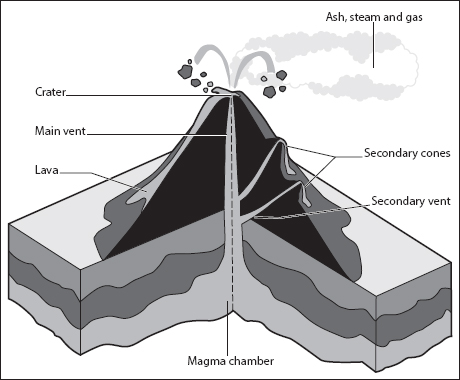
Several key phenomena are absolutely crucial for a proper understanding of the Galápagos. I hope these maps and diagrams help to illustrate the volcanoes, tectonic plates, hotspot, currents and habitats that have gone into making these extraordinary islands.

FIGURE C.1. Charles Darwin was intrigued by what went on inside a volcano and proposed the presence of an internal chamber of molten rock with the densest lava located near the bottom and the least dense rising to the top. This would allow lavas of different composition to emerge in one eruption and account for his observation that the rocks on the lower slopes of Santiago were darker and denser than those at the verdant summit.
FIGURE C.2. The Galápagos sits near the junction of three major tectonic plates: the Pacific, the Cocos and the Nazca. At the faults between these plates, magma bubbles up from the earth’s mantle, cooling to form new crust and driving the three plates in different directions. The East Pacific Rise runs from south to north, along the junction between the Pacific Plate to the west and the Cocos and Nazca Plates to the east. The Galápagos Rift is oriented from east to west between the Cocos Plate to the north and the Nazca Plate to the south. The islands that we call the Galápagos are the manifest pinnacles of a now submerged mountain range known as the Carnegie Ridge.
FIGURE C.3. The Galápagos Archipelago is explained by the existence of a deep-seated hotspot that periodically sends volcanoes bubbling to the surface of the Nazca Plate. Courtesy of the interaction between the three major tectonic plates, the Nazca Plate is moving steadily to the south-east and carrying each island—as if on a conveyor belt—away from the hotspot. As this happens, the island cools, shrinks and weathers away, eventually assuming a monumental position as a seamount on the undersea Carnegie Ridge.
FIGURE C.4. The interplay between oceanic currents has a profound effect upon the Galápagos ecology and climate. The strong, cold Humboldt Current flows up the coast of Peru, combining with the weaker, warmer Panama Current from the north to form the South Equatorial Current, which surges out into the Pacific from east to west along the equator. The Cromwell Current (or Pacific Equatorial Undercurrent) runs in the opposite direction. Between June and November, the Humboldt Current is the major player, its cold, north-westerly influence turning down the temperature in the islands and causing moisture in the warmer air to condense into a drizzling mist, or garúa. When the Humboldt slackens in December, the Panama Current becomes ascendant, the mist evaporates and the hot season begins. As the temperature of the water rises, evaporation increases, clouds grow and rain falls.
FIGURE C.5. The Galápagos climate accounts for the existence of three principal ecological zones: the coastal zone is characterized by its saltiness; the arid zone is particularly dry; and the highlands, which are fed by the garúa during the cool season and rain during the hot season, support an altogether more effulgent flora.